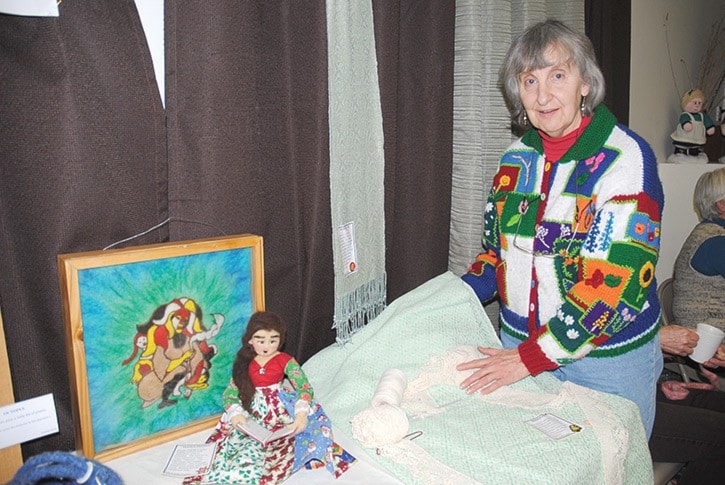The advantage of belonging to a craft guild is that you don’t have to put out a lot of money to get started in learning a skill and you have the support and friendship of its members.
The Williams Lake Spinners, Weavers and Fibre Artists Guild is just such a welcoming group in the lakecity.
The guild, which today has about 16 active members, maintains a studio in the Central Cariboo Arts Centre next to city hall.
Their collective resources include several large and small looms, spinning wheels and other equipment needed to prepare wool and other fibres for spinning and weaving.
The members hold workshops with local and visiting experts, and share their skills with each other.
Some of the artistic fibre art skills that the public doesn’t often see were on display during the guild’s Christmas Exhibition and Sale, held at the arts centre in December.
“Some of the pieces we make take so many hours to create that people would not be willing to pay the price they are worth,” says Linda Purjue, one of the members who exhibited some of the creations she makes for family and friends.
One of the pieces is a coverlet woven in a pale green, overshot pattern on a four-shaft, 100-inch loom that takes two people to operate.
Before starting her own project Purjue helped Dot Unrau to weave a coverlet on the large loom, then Unrau helped Purjue to warp the big loom for her coverlet project.
“Lesley Johnson helped me with the weaving,” Purjue says.
In weaving, the warp is the lengthwise or longitudinal threads on a loom, through which the cross threads, or weft, are woven to create the fabric.
Purjue and her helpers started the project last January, working on and off during the spring and summer, finishing it in about September.
Purjue is now in the process of making a knitted lace border for her coverlet which she estimates will involve 100 hours of work.
Purjue also had two examples of needle-felting in the show, both designs of her own creation.
Creating felt fabric or wall hangings usually involves water and heat to shrink raw wool fibres together, but in needle-felting, the wool is worked in a dry state using a barbed needle to “paint” the wool onto a backing, or to sculpt with it.
“It is absolutely amazing the detail you can do with needle-felting,” Purjue says. “There are incredible examples of needle-felting that go back 200 years or more.”
One of her needle-felted pieces on exhibition was a picture of a Mother Earth figure with four children behind her. Purjue dyed the wool for the piece in the colours of yellow, black, white and red to represent the four races of the world, and brown to represent the oneness of humanity.
“It’s commenting on the actual unity of the human race,” Linda says. “We all belong together.”
Another interesting piece of felting was a doll she calls Chantelle, because it is holding a Christmas carol book and appears to be singing, which she made as a Christmas tree topper.
Purjue had two other interesting woven pieces in the show which she termed “musical weaving.”
For these pieces, she began by writing a song about weaving, which she titled simply The Weaving Song. For a black and white scarf, she translated the musical score of the song into an eight-shaft weaving pattern by assigning a note to each of the shafts. For the second item, a multi-coloured jacket, she assigned a different colour to each note, then wove the same order of colours in a plain weave.
“It turned out to be a rather complex and colourful tartan,” Purjue says.
Unrau also had several pieces in the show which demonstrated some of the complexities that can be achieved in weaving fabric to make blankets and clothing.
For one blanket that fades from one colour to the other, she measured and set out the warp threads on a special holder where she could paint on dye of different colours along the length of them before warping the loom.
She also had several garments on display which she made from fabric which she wove.
She explained that one brown jacket, and one purple jacket, both with black undertones were woven on the same black warp, but look completely different because the weft threads were woven in different patterns and colours.
The Williams Lake Spinners, Weavers, and Fibre Artists Guild gathers together in the Guild room at the Art Centre twice weekly (Wednesday and Saturday from 10 a.m. to about noon). They are open to new members and are happy to teach newcomers their ancient crafts.
Throughout the year, the guild hosts a Spin In on the first Saturday of May, and frequently has workshops in spinning or weaving skills that are open to the public. They often do demonstrations of spinning and weaving at such venues as Canada Day in the Park, and the Williams Lake Harvest Fair.
